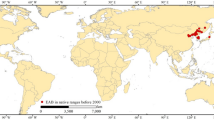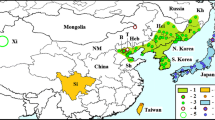Abstract
Climate change is likely to induce range divergence of invasive herbivore insects and native host trees given their different response rates to temperature increase. In this study we used the invasion of emerald ash borer (EAB, Agrilus planipennis Fairmaire), which is host-specific to ash (Fraxinus spp.), to demonstrate the significant implications of this climate change induced insect-host divergence for management of invasive species. The least constrained climatic limits of EAB were derived from its native range in East Asia, then projected to North America under the current and future climate conditions, and finally compared with the assumedly static ash distribution. Results suggest that the divergence between the invasion range of EAB and the distribution of ash in North America is likely to enlarge as climate change proceeds. In this case, many original ash stands could remain intact in the southern range, possibly forming refugia of the host species. The realization of this prediction, however, requires that the spread of EAB be reduced by continued management effort to allow climate change to take effect in time. Our study highlights the important role climate change has in the course of biological invasion and herbivore-host dynamics, which provides key information for continental scale pest risk prediction and strategic planning.


Similar content being viewed by others
References
Anulewicz A, McCullough D, Cappaert D, Poland T (2008) Host range of the emerald ash borer (Agrilus planipennis Fairmaire)(Coleoptera: Buprestidae) in North America: results of multiple-choice field experiments. Environ Entomol 37(1):230–241
Bale J, Hayward S (2010) Insect overwintering in a changing climate. J Exp Biol 213(6):980–994
Bale J, Masters G, Hodkinson I et al (2002) Herbivory in global climate change research: direct effects of rising temperature on insect herbivores. Glob Change Biol 8(1):1–16
Bauer L, Haack R, Miller D, Petrice T and Liu H (2003) Emerald ash borer life cycle. The emerald ash borer research and technology development meeting, Morgantown, WV, U.S. Forest Service, Forest Health Technology Enterprise Team, pp 8
Cappaert D, McCullough D, Poland T, Siegert N (2005) Emerald ash borer in North America: A research and regulatory challenge. Am Entomol 51(3):152–165
Chen IC, Hill JK, Ohlemüller R, Roy DB, Thomas CD (2011) Rapid range shifts of species associated with high levels of climate warming. Science 333:1024–1026
Chuine I (2010) Why does phenology drive species distribution? Philos T R Soc B 365(1555):3149
Cleland EE, Chuine I, Menzel A, Mooney HA, Schwartz MD (2007) Shifting plant phenology in response to global change. Trends Ecol Evol 22(7):357–365
Dixon AFG, Honěk A, Keil P, Kotela MAA, Šizling AL, Jarošík V (2009) Relationship between the minimum and maximum temperature thresholds for development in insects. Funct Ecol 23(2):257–264
Duan J, Ulyshen M, Bauer L, Gould J, Van Driesche R (2010) Measuring the impact of biotic factors on populations of immature emerald ash borers (Coleoptera: Buprestidae). Environ Entomol 39(5):1513–1522
Elith J, Phillips SJ, Hastie T, Dudík M, Chee YE, Yates CJ (2011) A statistical explanation of MaxEnt for ecologists. Divers Distrib 17:43–57
Fei S, Liang L, Paillet FL, Steiner KC, Fang J, Shen Z, Wang Z, Hebard FV (2012) Modelling chestnut biogeography for American chestnut restoration. Divers Distrib 18(8):754–768
Fielding AH, Bell JF (1997) A review of methods for the assessment of prediction errors in conservation presence/absence models. Environ Conserv 24(01):38–49
Gandhi K, Herms D (2010) North American arthropods at risk due to widespread Fraxinus mortality caused by the alien emerald ash borer. Biol Invasions 12(6):1839–1846
Gillott C (1995) Entomology, 2nd edn. Plenum Press, New York and London
Haack R, Jendak E, Houping L, Marchant K, Petrice T, Poland T, Ye H (2002) The emerald ash borer: a new exotic pest in North America. Newsl Mich Entomol Soc 47(3):1–5
Hausman C, Jaeger J, Rocha O (2010) Impacts of the emerald ash borer (EAB) eradication and tree mortality: potential for a secondary spread of invasive plant species. Biol Invasions 12:2013–2023
Hijmans R, Graham C (2006) The ability of climate envelope models to predict the effect of climate change on species distributions. Glob Change Biol 12(12):2272–2281
Hijmans R, Cameron S, Parra J, Jones P, Jarvis A (2005) Very high resolution interpolated climate surfaces for global land areas. Int J Climato 25(15):1965–1978
Hodkinson I, Bird J (1998) Host-specific insect herbivores as sensors of climate change in arctic and alpine environments. Arctic Alpine Res 30:78–83
Huberty C (1994) Applied Discriminant Analysis. Wiley-Interscience, New York
IPCC (2001) Climate Change 2001: The scientific basis. Contributions of working group I to the third assessment report of the intergovernmental panel on climate change. Cambridge University Press, UK
Iverson L, Prasad A (1998) Predicting abundance of 80 tree species following climate change in the eastern United States. Ecol Monogr 68(4):465–485
Iverson L, Prasad A, Matthews SN, Peters M (2008) Estimating potential habitat for 134 eastern US tree species under six climate scenarios. Forest Ecol Manag 254(3):390–406
Kelly AE, Goulden ML (2008) Rapid shifts in plant distribution with recent climate change. PNAS 105:11823–11826
Kovacs K, Haight R, McCullough D, Mercader R, Siegert N, Liebhold A (2010) Cost of potential emerald ash borer damage in US communities, 2009-2019. Ecol Econ 69(3):569–578
Lindell C, McCullough D, Cappaert D, Apostolou N, Roth M (2008) Factors influencing woodpecker predation on emerald ash borer. Am Midl Nat 159(2):434–444
Little EL (1971) Atlas of United States Trees Volume 1 Conifers and Important Hardwoods. Miscellaneous publication 1146. U.S. Department of Agriculture, Forest Service, Washington, DC
Liu H, Bauer L, Gao R, Zhao T, Petrice T, Haack R (2003) Exploratory survey for the emerald ash borer, Agrilus planipennis (Coleoptera: Buprestidae), and its natural enemies in China. Great Lakes Entomol 36:191–204
Lyons D, Jones G (2005) The biology and phenology of the emerald ash borer. In: Proceedings of 16th USDA interagency research forum on gypsy moth and other invasive species. pp 62–63
MacFarlane D, Meyer S (2005) Characteristics and distribution of potential ash tree hosts for emerald ash borer. Forest Ecol Manag 213:15–24
MacLean Jr SF (1983) Life cycles and the distribution of psyllids (Homoptera) in arctic and subarctic Alaska. Oikos:445–451
Muirhead JR, Leung B, Van Overdijk C et al (2006) Modelling local and long-distance dispersal of invasive emerald ash borer Agrilus planipennis (Coleoptera) in North America. Divers and Distrib 12:71–79
Peterson AT (2003) Predicting the geography of species’ invasions via ecological niche modeling. Q Rev Biol 78(4):419–433
Petitpierre B, Kueffer C, Broennimann O, Randin C, Daehler C, Guisan A (2012) Climatic niche shifts are rare among terrestrial plant invaders. Science 335(6074):1344–1348
Phillips S (2008) Transferability, sample selection bias and background data in presence-only modelling: a response to Peterson et al. (2007). Ecography 31(2):272–278
Phillips S, Dudík M (2008) Modeling of species distributions with Maxent: new extensions and a comprehensive evaluation. Ecography 31(2):161–175
Poland T, McCullough D (2006) Emerald ash borer: invasion of the urban forest and the threat to North America’s ash resource. J Forest 104(3):118–124
Prasad A, Iverson L, Peters M, Bossenbroek J, Matthews S, Davis Sydnor T, Schwartz M (2010) Modeling the invasive emerald ash borer risk of spread using a spatially explicit cellular model. Landscape Ecol 25:353–369
Pureswaran D, Poland T (2009) Host selection and feeding preference of Agrilus planipennis (Coleoptera: Buprestidae) on ash (Fraxinus spp.). Environ Entomol 38(3):757–765
Rebek EJ, Herms DA, Smitley DR (2008) Interspecific variation in resistance to emerald ash borer (Coleoptera: Buprestidae) among North American and Asian ash (Fraxinus spp.). Environ Entomol 37(1):242–246
Rohli RV, Vega AJ (2008) Climatology. Jones & Bartlett Learning, Sudbury
Rosenzweig C, Casassa G, Karoly DJ et al (2007) Assessment of observed changes and responses in natural and managed systems. In: Parry M et al (eds) Climate change 2007: impacts, adaptation and vulnerability. Contribution of working group II to the fourth assessment report of the intergovernmental panel on climate change. Cambridge University Press, UK, pp 79–131
San Souci J, Hanou I, Puchalski D (2009) High-resolution remote sensing image analysis for early detection and response planning for emerald ash borer. Photogramm Eng Rem S 75:905–909
Sobek-Swant S, Kluza DA, Cuddington K, Lyons DB (2012) Potential distribution of emerald ash borer: What can we learn from ecological niche models using Maxent and GARP? Forest Ecol Manag 281:23–31
Strubbe D, Broennimann O, Chiron F, Matthysen E (2013) Niche conservatism in non-native birds in Europe: niche unfilling rather than niche expansion. Global Ecol Biogeogr 22:962–970
USDA–APHIS (2013) Emerald ash borer program manual, Agrilus planipennis (Fairmaire) USDA–APHIS–PPQ–Plant Health Programs – Pest Management, Riverdale, Maryland
Venette R, Abrahamson M (2010) Cold hardiness of emerald ash borer, Agrilus planipennis: a new perspective. In: Black ash symposium, Bemidji, MN, 2010. U.S. Department of Agriculture, Forest Service, Chippewa National Forest
Vermunt B, Cuddington K, Sobek-Swant S, Crosthwaite J (2012) Cold temperature and emerald ash borer: Modelling the minimum under-bark temperature of ash trees in Canada. Ecol Model 235–236:19–25
Wang X, Yang Z, Gould J, Zhang Y, Liu G, Liu E (2010) The biology and ecology of the emerald ash borer, Agrilus planipennis, in China. J Insect Sci 128:1–23
Wei X, Reardon D, Wu Y, Sun J (2004) Emerald ash borer, Agrilus planipennis Fairmaire (Coleoptera: Buprestidae), in China: a review and distribution survey. Acta Entomol Sinica 47(5):679–685
Wiens J, Graham C (2005) Niche conservatism: integrating evolution, ecology, and conservation biology. Annu Rev Ecol Evol S 36:519–539
Zweig M, Campbell G (1993) Receiver-operating characteristic (ROC) plots: a fundamental evaluation tool in clinical medicine. Clin Chem 39(4):561–577
Acknowledgments
We thank Jonathan Phillips and John Cox for helpful comments and editorial support. Jonathan Lelito (USDA-APHIS) provided valuable information on the up to date development of EAB ecophysiology research. Douglas A. Bopp (USDA-APHIS) provided historical EAB infested county maps Erin Bullas-Appleton (Canadian Food Inspection Agency) also provided EAB distribution maps in Canada. We also thank the three anonymous reviewers for their constructive comments. This study was partially supported by a NSF Grant (No. 1241932).
Author information
Authors and Affiliations
Corresponding author
Electronic supplementary material
Below is the link to the electronic supplementary material.
ESM 1
(DOCX 482 kb)
Rights and permissions
About this article
Cite this article
Liang, L., Fei, S. Divergence of the potential invasion range of emerald ash borer and its host distribution in North America under climate change. Climatic Change 122, 735–746 (2014). https://doi.org/10.1007/s10584-013-1024-9
Received:
Accepted:
Published:
Issue Date:
DOI: https://doi.org/10.1007/s10584-013-1024-9




